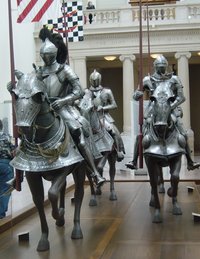Plate armour
|
|
Plate armour is personal armour made from large metal plates, worn on the chest and sometimes the entire body. Plate armour protecting the chest and the lower limbs was used by the ancient Greeks and Romans, but it fell into disuse after the collapse of the Roman Empire. Single plates of metal armour were again used from the late 13th century on, to protect joints and shins, and these were worn over full chainmail. By the end of the 14th century, larger and complete full plates of armour had been developed. During the early 1500s the helmet and neckguard design was reformed to produce the so-called Nürnberg armours, many of them masterpieces of workmanship and design. European leaders in armouring techniques were northern Italians and southern Germans. This led to the styles of Milanese from Milan, and Gothic from Germany. Eventually England produced armour in Greenwich which equalled the masters of Europe, and they developed their own unique style.
The threaded screws used in armour were used in other industries and may have been invented by clockmakers or other machinists.
Full plate armour was very expensive to produce and remained therefore restricted to the upper strata of society, and lavishly decorated suits of armour remained the fashion with 17th century nobles and generals, long after they had ceased to be militarily useful due to the introduction of firearms in the battlefield. Reduced plate armour, typically consisting of a breastplate, a burgonet, morion or cabasset and gauntlets, however, became also popular among 16th century mercenaries. From the 15th century on, armour specifically designed for jousting (rather than for battle) and parade armours also became popular. Many of the latter were decorated with biblical or mythological motifs.

Philip_II.jpg
Cod2823_fol150r.jpg
Evolution of plate armour also triggered developments in the design of offensive weapons. While this armour was effective against cuts or blows, they could be pierced by bolts fired by powerful crossbows, and also by long-tapered swords designed for the purpose. Maces were used not to pierce the armour, but to inflict blunt trauma right through the armour. Another small weakness in plate armour was the joints, where the plates overlapped; this could expose unprotected gaps in certain stances of the wearer, through which sword and dagger blades could penetrate. In armoured techniques taught in german school of swordsmanship, the attacker concentrates on these cracks, resulting in a fighting style very different from unarmoured sword-fighting. Because of that weakness, most warriors wore a chainmail shirt beneath their plate armour (or coat-of-plates). After that the armpits were protected with chainmail patches sewn onto a gambeson or arming jacket. Further protection for plate armour were small round plates called besagews that covered the armpit area.
Plate armour could have consisted of a helmet, a gorget, pauldrons (or spaulders), couters, vambraces, gauntlets, a cuirass (back and breastplate) with a fauld, tassets and a culet, a chainmail skirt, cuisses, poleyns, greaves and sabatons. While it looks heavy, a full plate armour set could be as light as only 45 pounds if well made of tempered steel. The weight was so well spread over the body that a fit man could run, or jump into his saddle. That it was necessary to lift a fully armed knight onto his horse with the help of pulleys is a myth originating in Mark Twain's A Connecticut Yankee in King Arthur's Court, and has no historical base. Even knights in enormously heavy jousting armour were not winched onto their horses. This type of "sporting" armour was meant only for ceremonial lancing matches and the design had to be extremely thick to prevent severe accidents, such as the one causing the death of King Henry II of France.
For a notable use of plate armour in the 19th century see the story of Australian villain Ned Kelly. Imperial Japanese musketeer troops continued to use plate armour well into the early 19th century. Plate armour briefly re-appeared during WWII on some Soviet guardian (elite) infantry units, who wore steel chestplates; and the USAF flak jacket also deserves mention. The 1970s introduction of kevlar body armour brought sheet metal (especially titanium) trauma plates back into fashion as a form of rifle-grade add-on to flexible vests.
